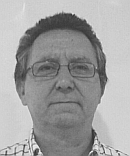 Professor
Eloy Velasco Gómez
Professor
Eloy Velasco Gómez










Eloy Velasco Gómez began his research career in
1989 after graduating in Chemical Sciences by the University of Valladolid,
getting his PhD in Industrial Engineering in 1998. From 1995 is member of
the Department of Thermal Engineering and Fluid-mechanics, where he is
nowadays Professor.
His teaching activity is related to the field of
heat and mass transfer, thermal engineering and HVAC systems. He also has
participated in doctorate programs at the High Technical School of
Industrial Engineering of the University of Valladolid, as well as in master
courses in different Spanish Universities and expertise courses. He has
co-supervised numerous doctoral theses, being the most of them developed
within doctorate programs with quality mention.
His research lines cover energy recovery
systems, evaporative cooling systems, thermal storage and radiant
dissipation, Indoor Environment Quality, Energy Efficiency of Buildings and
optimization of performance of thermal building services.
Resulting from his research activity, he has
published several books, monographic and book chapters, more than 20
articles published in high-impact indexed journals and numerous
contributions to national and international congresses.
Research Projects
-
The University of Valladolid towards a
sustainable energy system: High Indoor Environment Quality, competitive and
decarbonized
-
Analysis of energy-efficient technologies for
building sustainability
-
Energy assessment and thermal comfort
measurement in university buildings towards zero energy by combining
indirect evaporative cooling and Thermally Activated Building Structures
-
Development of a smart thermal network
manager (GIRTER)
-
Design and Integrated operation Optimization of
Radiant systems Thermally activated by low energy sources in Mediterranean
climate
-
Ibero-American Network on Energy management and
efficiency for a sustainable development (GEESOS)
-
Design, fabrication and characterization of a
high energy efficiency combined HVAC system: Semi-indirect ceramic
evaporative cooler, solar air thermal collectors and Heat-pump
-
Reduction of energy consumption and carbon
dioxide emission in buildings combining evaporative cooling, free cooling
and energy recovery in all-air systems
-
Calculation, design, construction and
characterization of an environmental friendly evaporative cooling system
operating by water-to-air convective diffusion from an humid surface
-
Fabrication,
monitoring and modeling of a low environmental impact air conditioning
equipment using a combined system: ceramic evaporative cooler and heat pipes
recover
-
Tri-energy recovery at low temperature by means
of a combined system composed by a ceramic evaporative cooler, a heat pipes
recover and an air-to-air heat-pump
-
Design, fabrication and energy analysis of an
ceramic indirect evaporative cooler for air conditioning systems
-
Residual energy recovery from low temperature airflow by
means of ceramic exchange systems with evaporative refrigeration
-
Study and optimization of the energy
variables that characterize the stages of fabrication of chicory and
soluble cereals
-
Optimization of low temperature solar collectors for their
architectural integration within the building envelope
Indexed Journal Articles
-
Improved performance of a PV integrated ventilated
façade at an existing NZEB
-
Analysis of the Methodology to Obtain Several Key Indicators Performance
(KIP), by Energy Retrofitting of the Actual Building to the District Heating
Fuelled by Biomass, Focusing on nZEB Goal: Case of Study
-
Monitoring Data Study of the Performance of Renewable Energy Systems in a
Near Zero Energy Building in Spain: A Case Study
-
Modelling the long-term effect of climate change on a zero energy and
carbon dioxide building through energy efficiency and renewables
-
Energy analysis at a near zero energy building. A case-study in Spain
-
A new method for calculating conduction response factors for multilayer
constructions based on frequency–Domain spline interpolation (FDSI) and
asymptotic analysis
-
Assessing the applicability of passive cooling and heating techniques
through climate factors: An overview
-
Indoor air quality and thermal comfort evaluation in a spanish modern low-energy
office with thermally activated building systems
-
Influence of constructive parameters on the performance of two indirect
evaporative cooler prototypes
-
Experimental study on the cooling capacity of a radiant cooled ceiling
system
-
Experimental characterisation of an indirect evaporative cooling prototype
in two operating modes
-
The
harmonic method: A new procedure to obtain wall periodic cross response
factors
-
Life cycle assessment of a semi-indirect ceramic evaporative cooler vs. a
heat pump in two climate areas of Spain
-
Comparative study between a ceramic evaporative cooler (CEC) and an air-source
heat pump applied to a dwelling in Spain
-
Experimental characterisation of the operation and comparative study of two
semi-indirect evaporative systems
-
Life cycle analysis of a thermal solar installation at a
rural house in Valladolid (Spain)
-
Thermal comfort analysis of a low temperature waste energy recovery system:
SIECHP
-
Building
Energy Analysis (BEA): A methodology to assess building energy labelling
-
Description and experimental results of a semi-indirect ceramic evaporative
cooler
-
Life cycle assessment and external environmental cost analysis of heat pumps
-
Comparative study of two different evaporative systems: An indirect
evaporative cooler and a semi-indirect ceramic evaporative cooler
-
Design and experimental study of a mixed energy recovery system, heat pipes
and indirect evaporative equipment for air conditioning
-
Experimental study of indoor air quality, energy
saving and analysis of ventilation norms in climatised areas
-
Study on environmental quality of a surgical block
-
Simulation model of an indirect evaporative cooler
-
Biomass as an energy resource in Castilla y León (Spain)
-
The selection of testing methods for biofuels using the Taguchi signal-to-noise
ratio
-
Salt Effect on Vapor–Liquid Equilibrium of Methyl tert-Butyl Ether +
Methanol at 298.15 K
◄Members


 Professor
Eloy Velasco Gómez
Professor
Eloy Velasco Gómez